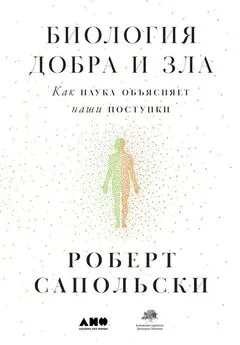Роберт Сапольски - Биология добра и зла. Как наука объясняет наши поступки
- Название:Биология добра и зла. Как наука объясняет наши поступки
- Автор:
- Жанр:
- Издательство:Альпина нон-фикшн
- Год:2019
- Город:Москва
- ISBN:978-5-0013-9051-0
- Рейтинг:
- Избранное:Добавить в избранное
-
Отзывы:
-
Ваша оценка:
Роберт Сапольски - Биология добра и зла. Как наука объясняет наши поступки краткое содержание
Биология добра и зла. Как наука объясняет наши поступки - читать онлайн бесплатно ознакомительный отрывок
Интервал:
Закладка:
375
A. Kusserow, “De-homogenizing American Individualism: Socializing Hard and Soft Individualism in Manhattan and Queens,” Ethos 27 (1999): 210.
376
S. Ullal-Gupta et al., “linkhing Prenatal Experience to the Emerging Musical Mind,” Front Systems Nsci 3 (2013): 48.
377
A. DeCasper and W. Fifer, “Of Human Bonding: Newborns Prefer Their Mothers’ Voices,” Sci 6 (1980): 208; A. J. DeCasper and P. A. Prescott, “Human Newborns’ Perception of Male Voices: Preference, Discrimination, and Reinforcing Value,” Developmental Psychobiology 17 (1984): 481; B. Mampe et al., “Newborns’ Cry Melody Is Shaped by Their Native Language,” Curr Biol 19 (2009): 1994; A. DeCasper and M. Spence, “Prenatal Maternal Speech Influences Newborns’ Perception of Speech Sounds,” Infant Behav and Development 9 (1986): 133.
378
J. P. Lecanuet et al., “Fetal Perception and Discrimination of Speech Stimuli: Demonstration by Cardiac Reactivity: Preliminary Results,” Comptes rendus de l’Académie des sciences III 305 (1987): 161; J. P. Lecanuet et al., “Fetal Discrimination of Low-Pitched Musical Notes,” Developmental Psychobiology 36 (2000): 29; C. Granier-Deferre et al., “A Melodic Contour Repeatedly Experienced by Human Near-Term Fetuses Elicits a Profound Cardiac Reaction One Month After Birth,” PLoS ONE 23 (2011): e17304.
379
G. Kolata, “Studying Learning in the Womb,” Sci 225 (1984): 302; A. J. DeCasper and M. J. Spence, “Prenatal Maternal Speech Influences Newborns’ Perception of Speech Sounds,” Infant Behav and Development 9 (1986): 133.
380
P. Y. Wang et al., “Müllerian Inhibiting Substance Contributes to Sex-linkhed Biases in the Brain and Behavior,” PNAS 106 (2009): 7203; S. Baron-Cohen et al., “Sex Differences in the Brain: Implications for Explaining Autism,” Sci 310 (2005): 819.
381
R. Goy and B. McEwen, Sexual Differentiation of the Brain (Cambridge, MA: MIT Press, 1980).
382
J. Money, “Sex Hormones and Other Variables in Human Eroticism,” in Sex and Internal Secretions , ed. W. C. Young, 3rd ed. (Baltimore: Williams and Wilkins, 1963), p. 138.
383
G. M. Alexander and M. Hines, “Sex Differences in Response to Children’s Toys in Nonhuman Primates ( Cercopithecus aethiops sabaeus ),” EHB 23 (2002): 467 (рисунок в тексте из этого источника). J. M. Hassett et al., “Sex Differences in Rhesus Monkey Toy Preferences Parallel Those of Children,” Horm Behav 54 (2008): 359.
384
K. Wallen and J. M. Hassett, “Sexual Differentiation of Behavior in Monkeys: Role of Prenatal Hormones,” J Neuroendocrinology 21 (2009): 421; J. Thornton et al., “Effects of Prenatal Androgens on Rhesus Monkeys: A Model System to Explore the Organizational Hypothesis in Primates,” Horm Behav 55 (2009): 633.
385
M. Hines, Brain Gender (New York: Oxford University Press, 2004); G. A. Mathews et al., “Personality and Congenital Adrenal Hyperplasia: Possible Effects of Prenatal Androgen Exposure,” Horm Behav 55 (2009): 285; R. W. Dittmann et al., “Congenital Adrenal Hyperplasia. I: Gender-Related Behavior and Attitudes in Female Patients and Sisters,” PNE 15 (1990): 401; A. Nordenstrom et a l., “Sex-Typed Toy Play Correlates with the Degree of Prenatal Androgen Exposure Assessed by CYP21 Genotype in Girls with Congenital Adrenal Hyperplasia,” J Clin Endo and Metabolism 87 (2002): 5119; V. L. Pasterski et al., “Increased Aggression and Activity Level in 3- to 11-Year-Old Girls with Congenital Adrenal Hyperplasia,” Horm Behav 52 (2007): 368.
386
C. A. Quigley et al., “Androgen Receptor Defects: Historical, Clinical, and Molecular Perspectives,” Endocrine Rev 16 (1995): 271; N. P. Mongan et al., “Androgen Insensitivity Syndrome,” Best Practice & Res: Clin Endo & Metabolism 29 (2015): 569.
387
F. Brunner et al., “Body and Gender Experience in Persons with Complete Androgen Insensitivity Syndrome,” Zeitschrift für Sexualforschung 25 (2012): 26; F. Brunner et al., “Gender Role, Gender Identity and Sexual Orientation in CAIS (‘XY-Women’) Compared with Subfertile and Infertile 46,XX Women,” J Sex Res 2 (2015): 1; D. G. Zuloaga et al., “The Role of Androgen Receptors in the Masculinization of Brain and Behavior: What We’ve Learned from the Testicular Feminization Mutation,” Horm Behav 53 (2008): 613; H. F. L. Meyer-Bahlburg, “Gender Outcome in 46,XY Complete Androgen Insensitivity Syndrome: Comment on T’Sjoen et al.,” Arch Sexual Behav 39 (2010): 1221; G. T’Sjoen et al., “Male Gender Identity in Complete Androgen Insensitivity Syndrome,” Arch Sexual Behav 40 (2011): 635.
388
J. Hönekopp et al., “2nd to 4th Digit Length Ratio (2D:4D) and Adult Sex Hormone Levels: New Data and a Meta-analytic Review,” PNE 32 (2007): 313.
389
Данные по мужской агрессии и уверенности в себе: C. Joyce et al., “2nd to 4th Digit Ratio Confirms Aggressive Tendencies in Patients with Boxers Fractures,” Injury 44 (2013): 1636; M. Butovskaya et al., “Digit Ratio (2D:4D), Aggression, and Dominance in the Hadza and the Datoga of Tanzania,” Am J Human Biology 27 (2015): 620;
СДВГ и аутизм: D. McFadden et al., “Physiological Evidence of Hypermasculination in Boys with the Inattentive Subtype of ADHD,” Clinical Neurosci Res 5 (2005): 233; M. Martel et al., “Masculinized Finger-Length Ratios of Boys, but Not Girls, Are Associated with Attention Deficit/ Hyperactivity Disorder,” Behavioral Neuroscience 122 (2008): 273; J. Manning et al., “The 2nd to 4th Digit Ratio and Autism,” Development Medicine Child Neurology 43 (2001): 160.
Депрессия и тревога: A. Bailey et al., “Depression in Men Is Associated with More Feminine Finger Length Ratios,” Pers Individ Diff 39 (2005): 829; M. Evardone et al., “Anxiety, Sex-linkhed Behavior, and Digit Ratios,” Arch Sex Behav . 38 (2009): 442–55.
Доминирование: N. Neave et al., “Second to Fourth Digit Ratio, Testosterone and Perceived Male Dominance,” Proc Royal Society B 270 (2003): 2167.
Почерк: J. Beech et al., “Do Differences in Sex Hormones Affect Handwriting Style? Evidence from Digit Ratio and Sex Role Identity as Determinants of the Sex of Handwriting,” Pers Individ Diff 39 (2005): 459.
Сексуальная ориентация: K. Hirashi et al., “The Second to Fourth Digit Ratio in a Japanese Twin Sample: Heritability, Prenatal Hormone Transfer, and Association with Sexual Orientation,” Arch Sex Behav 41 (2012): 711; A. Churchill et al., “The Effects of Sex, Ethnicity, and Sexual Orientation on Self-Measured Digit Ratio,” Arch Sex Behav 36 (2007): 251.
Данные по женщинам, касающиеся аутизма: J. Manning et al., “The 2nd to 4th Digit Ratio and Autism,” DevMed Child Neurol 43 (2001): 160.
Анорексия: S. Quinton et al., “The 2nd to 4th Digit Ratio and Eating Disorder Diagnosis in Women,” Pers Individ Diff 51 (2011): 402. Доминирование одной из рук: B. Fink et al., “2nd to 4th Digit Ratio and Hand Skill in Austrian Children,” Biol Psychology 67 (2004): 375.
Сексуальная ориентация и сексуальное поведение: T. Grimbos et al., “Sexual Orientation and the 2nd to 4th Finger Length Ratio: A Meta-Analysis in Men and Women,” Behav Neurosci 124 (2010): 278; W. Brown et al., “Differences in Finger Length Ratios Between Self-Identified ‘Butch’ and ‘Femme’ Lesbians,” Arch Sex Behav 31 (2002): 123.
390
К сноске: A. Lamminmaki et al., “Testosterone Measured in Infancy Predicts Subsequent Sex-Typed Behavior in Boys and in Girls,” Horm Behav 61 (2012): 611; G. Alexander and J. Saenz, “Early Androgens, Activity Levels and Toy Choices of Children in the Second Year of Life,” Horm Behav 62 (2012): 500.
391
B. Heijmans et al., “Persistent Epigenetic Differences Associated with Prenatal Exposure to Famine in Humans,” PNAS 105 (2008): 17046.
392
Большой обзор предлагается здесь: D. Moore, The Developing Genome: An Introduction to Behavioral Genetics. (Oxford: Oxford University Press, 2015).
393
Weaver et al., “Epigenetic Programming by Maternal Behavior,” Nature Neurosci 7 (2004): 847; R. Sapolsky, “Mothering Style and Methylation ,” Nature Neurosci 7 (2004): 791; D. Francis et al., “Nongenomic Transmission Across Generations of Maternal Behavior and Stress Response in the Rat,” Science 286 (2004): 1155.
394
N. Provencal et al., “The Signature of Maternal Rearing in the Methylome in Rhesus Macaque Prefrontal Cortex and T Cells,” J Neurosci 32 (20120: 15626; T. L. Roth et al., “Lasting Epigenetic Influence of Early-Life Adversity on the BDNF Gene,” BP 65 (2009): 760; E. C. Braithwaite et al., “Maternal Prenatal Depressive Symptoms Predict Infant NR3C1 1F and BDNF IV DNA Methylation,” Epigenetics 10 (2015): 408; C. Murgatroyd et al., “Dynamic DNA Methylation Programs Persistent Adverse Effects of Early-Life Stress,” Nat Nsci 12 (2009): 1559; M. J. Meaney and M. Szyf, “Environmental Programming of Stress Responses Through DNA Methylation: Life at the Interface Between a Dynamic Environment and a Fixed Genome,” Dialogues in Clin Neuroscience 7 (2005): 103; P. O. McGowan et al., “Broad Epigenetic Signature of Maternal Care in the Brain of Adult Rats,” PLoS ONE 6 (2011): e14739; D. Liu et al., “Maternal Care, Hippocampal Glucocorticoid Receptors, and Hypothalamic-Pituitary-Adrenal Responses to Stress,” Sci 277 (1997): 1659; T. Oberlander et al., “Prenatal Exposure to Maternal Depression, Neonatal Methylation of Human Glucocorticoid Receptor Gene (NR3C1) and Infant Cortisol Stress Responses,” Epigenetics 3 (2008): 97; F. A. Champagne, “Epigenetic Mechanisms and the Transgenerational Effects of Maternal Care,” Front Neuroendocrinology 29 (2008): 386; J. P. Curley et al., “Transgenerational Effects of Impaired Maternal Care on Behaviour of Offspring and Grandoffspring,” Animal Behav 75 (2008): 1551; J. P. Curley et al., “Social Enrichment During Postnatal Development Induces Transgenerational Effects on Emotional and Reproductive Behavior in Mice,” Front Behav Nsci 3 (2009): 1; F. A. Champagne, “Maternal Imprints and the Origins of Variation,” Horm Behav 60 (2011): 4; F. A. Champagne and J. P. Curley, “Epigenetic Mechanisms Mediating the Long-Term Effects of Maternal Care on Development,” Nsci Biobehav Rev 33 (2009): 593; F. A. Champagne et al., “Maternal Care Associated with Methylation of the Estrogen Receptor-alpha1b Promoter and Estrogen Receptor-Alpha Expression in the Medial Preoptic Area of Female Offspring,” Endo 147 (2006): 2909; F. A. Champagne and J. P. Curley, “How Social Experiences Influence the Brain,” Curr Opinion in Neurobiol 15 (2005): 704.
Читать дальшеИнтервал:
Закладка:





![Роберт Сапольски - Игры тестостерона и другие вопросы биологии поведения [litres]](/books/1074102/robert-sapolski-igry-testosterona-i-drugie-vopros.webp)




